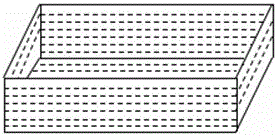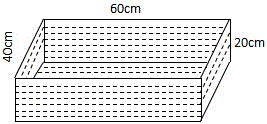Method for reducing farmland drainage canal nitrogen and phosphorus loss through charcoal
A technology of farmland drainage and biochar, which is applied in the field of agricultural non-point source pollution control, can solve problems such as poor drainage, reduced effect of ecological ditch reduction, and waterlogging of farmland, and achieve the effect of maintaining smooth water flow, easy implementation, and simple operation
- Summary
- Abstract
- Description
- Claims
- Application Information
AI Technical Summary
Problems solved by technology
Method used
Image
Examples
Embodiment 1
[0039] A farmland drainage ditch was randomly selected in a vegetable field in the suburbs of Guangzhou, and a biochar matrix frame system was constructed according to the following steps.
[0040] S1. Set the matrix frame, see figure 1 As shown, the width of the matrix frame is controlled at 3 / 4 or less of the width of the farmland drainage ditch, and holes are provided in the matrix frame to facilitate the normal flow of ditch water;
[0041] S2. Spread a layer of fine gravel at the bottom of the matrix frame, and then fill in a mixed matrix composed of soil matrix and biochar;
[0042] S3. Transplanting aquatic plant seedlings in the mixed substrate;
[0043] S4. The matrix frame is placed in the farmland drainage ditch, and the matrix frame is kept a certain width away from both sides of the ditch.
[0044] Specifically, in this embodiment, the width of the farmland drainage ditch is 0.8-1.2 m, and the average width is 1.0 m. Prepare plastic frames with length (m), widt...
Embodiment 2
[0046] Refer to Example 1 for the implementation steps. The implementation test was carried out in August 2015, and the specific implementation method is the same as above.
[0047] The indoor simulated soil column leaching test method was used to test the effect of biochar on the loss of soil nitrogen and phosphorus. The proportions of biochar added to the soil were 2%, 4%, 6% and 8%, respectively, and no addition treatment was set. For comparison, see Figure 4 and Figure 5 shown ( Figure 4 and Figure 5 Numbers 1 to 10 in the middle right column indicate the number of water leaching times in the test). The test results showed that there was a significant difference between the biochar treatment and the control (p<0.05), the greater the amount of biochar added, the smaller the leaching loss of soil TN and TP. Therefore, biochar can effectively reduce the leaching loss of soil TN and TP.
[0048] The method of indoor hydroponic experiment was adopted to test the reduc...
Embodiment 3
[0051] The implementation test was implemented in April, 2015, and the specific implementation method was the same as above, and the effect of reducing nitrogen and phosphorus with biochar and aquatic plants for the test implementation was the same as in Example 1. In order to test the implementation effect of the technology of the present invention, sampling sections were respectively set at the upstream (before the iris) and the downstream end (behind the barracuda) of the ecological ditch constructed by the technology of the present invention, and the changes in nitrogen and phosphorus concentrations were continuously sampled and monitored after a rainfall. Another 50m farmland natural drainage ditch (with weeds growing naturally on both sides of the ditch) was selected as a control for monitoring over the same period. The results are shown in Table 1. The results in Table 1 show that the average removal rate of TN and TP after one rainfall in the ecological ditch constructe...
PUM
 Login to View More
Login to View More Abstract
Description
Claims
Application Information
 Login to View More
Login to View More - R&D
- Intellectual Property
- Life Sciences
- Materials
- Tech Scout
- Unparalleled Data Quality
- Higher Quality Content
- 60% Fewer Hallucinations
Browse by: Latest US Patents, China's latest patents, Technical Efficacy Thesaurus, Application Domain, Technology Topic, Popular Technical Reports.
© 2025 PatSnap. All rights reserved.Legal|Privacy policy|Modern Slavery Act Transparency Statement|Sitemap|About US| Contact US: help@patsnap.com



